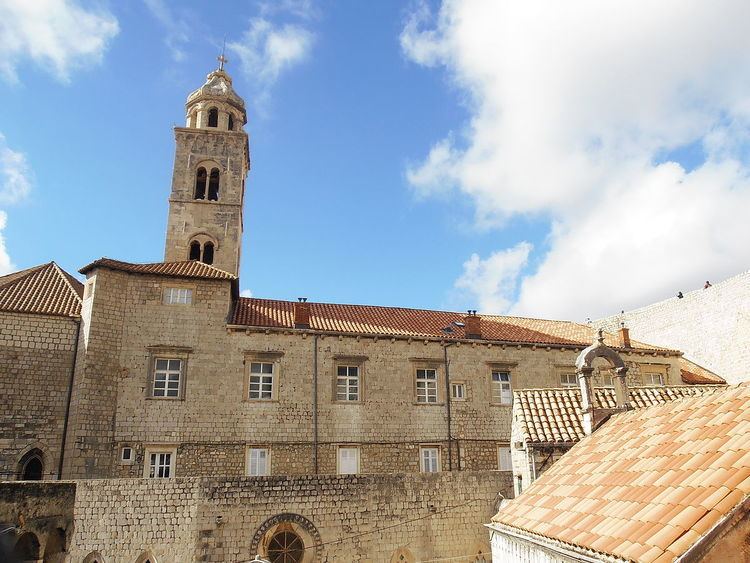Abbreviation HDP Provincial Slavko Slišković, OP | Formation 1380 Website dominikanci.hr | |
 | ||
Location | ||
The Croatian Dominican Province of the Annunciation of the Blessed Virgin Mary (Croatian: Hrvatska dominikanska provincija Navještenja Blažene Djevice Marije) is a province of the Dominican Order, Roman Catholic order founded in the 13th century. The Province has 13 convents and houses located in Bosnia and Herzegovina, Croatia and Slovenia.
Contents
Hungarian Province
On the second General Chapter of the Order in 1221, Saint Dominic entrusted his associate Paul the Dalmatian to implant the Order in the Kingdom of Hungary-Croatia. In the Middle Ages the Dominicans spread to all Croatian areas. First they came in Dubrovnik in 1225 and at the beginning of the 14th century they began to build the monumental complex of the Convent and church of Saint Dominic. During the 13th century they established monasteries in Nin (1228), Čazma (1229), Ban Brdo in Vrhbosna (1233), Dubica (1235), Zagreb (before 1241), Virovitica (before 1242), Zadar (1244), Split, Croatia (1245), Pag (c. 1250), Ulcinj (1258), Trogir (1265), Bihać (1266), Kotor (1266), Skradin (before 1312) and Brskovo (1285). In the 14th century several convents were established: Požega (1303), Hvar (1312), Šibenik (1346), Bosanska Krupa (before 1357) and Senj (before 1378) and Krk (before 1380). Until 1380 the Croatian convents were part of the Hungarian Province with vicars for the area along the Adriatic Sea.
Dalmatian Province
Pope Urban VI recognized complete autonomy of the Dalmatian Province in the bull Sedis Apostolicae of March 3, 1380. Newly erected Province of Dalmatia covered convents along the eastern Adriatic and had its headquarters in Zadar. During the 15th and 16th century numerous convents were established: Rab (1426), Čiovo (1432), Gruž (1437), Bol (1474), Rijeka (1477), Korčula (1501), Budva (1513) and others.
Dubrovnik Congregation
Following the process of reform in the Order, the reformed Congregation of Dubrovnik was founded in 1486, uniting three priories in the territory of the Republic of Ragusa: St. Dominic's Priory in Dubrovnik, Holy Cross Priory in Gruž and St. Nicholas' Priory in Lopud. Congregation spread with the foundation of new priories: on the island Ruda (1535), in Župa dubrovačka, Broci (1628), Viganj (1671) and Orašac (1690).
Congregation of Senj
Priories of Senj, Modruš and Bihać located on the territory of the Croatian-Hungarian Kingdom formed Congregation of Senj (Congregation of Croatia) in 1508, which, in some documents of the Order is also called the Province of Croatia. In these convents existed an effort to counter the impact from Dalmatia, which was under Venetian rule and thus had the support of the Hungarian king. Later the Congregation grew with the foundation of new priories: Trsat, Brinje, Kraljevica, Veruda and Gradišće. The majority of these priories were destroyed during the Ottoman invasion. The last time that mention is made of this Congregation is in 1585.
The rise and fall of the Dalmatian province
In the mid 15th century, the Province had about seventy convents and 2,000 members, but that number has started to decrease drastically due to the Ottoman invasion. Turkish raids in Bosnia, Slavonia, Lika and Dalmatia had destroyed almost completely the Dominican presence there. So in 1573 Dalmatian province had only a hundred members in eight convents. To 1583. number of convents increased to thirteen. During the 17th century the number of convents and members remained largely the same.
Since the Republic of Dubrovnik was spared of the Turkish conquest nor convents of the Dubrovnik congregation were not destroyed. Until the second half of the 17th century, the Congregation flourished and had seven convents, but after the devastating earthquake from 1667, the Congregation, because death of many members and significant material damage, experienced its decline.
Extensive damage to the Province inflicted the laws that Venetian Republic began to introduce during the 18th century and that restricted many of the rights of the religious orders. With the arrival of the French government in Dalmatia in the early 19th century, the state occupied and abolished many convents including that of Zadar, seat of the Province through the centuries and place where a university existed from 1389 until the abolishment of the convent in 1807. After Austria took over Dalmatia in 1814 situation insignificantly improves. Province in 1833 had had only six convents and 21 members.
Since the Dubrovnik congregation was threatened with extinction, with only 10 members in several rooms in two occupied convents (Dubrovnik and Gruž), the unification of the Congregation with the Dalmatian province was decided in 1835. The seat of the Province is then moved to Dubrovnik.
The recovery of the Province
Province began to recover after the First World War and so in 1927 founded the convent in Zagreb, in 1945 the house in Subotica, and in 1951 the convent in Rijeka. Since it began to spread to other areas of the Croatian ethnic areas, Province rejected the regional name and was called the Croatian Dominican province in 1963. With the foundation of the house at Klopče in 1978, the Province returned to Bosnia. The Province moved beyond the Croatian frontiers with the foundation of a house at Žalec and Petrovče in Slovenia in 1967 and 1986.
Former convents
Incomplete list of former convents of the Croatian Dominican Province:
